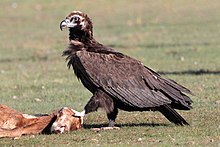Avicide
An avicide is any substance (normally, a chemical) which can be used to kill birds.

Commonly used avicides include strychnine, DRC-1339 (3-chloro-4-methylaniline hydrochloride, Starlicide) and CPTH (3-chloro-p-toluidine, the free base of Starlicide), and Avitrol (4-aminopyridine). Chloralose is also used as an avicide. In the past, highly concentrated formulations of parathion in diesel oil were also used, applied by aircraft spraying over the nesting colonies of the birds. It is impossible to minimize risk from avicides for non-targets species.[citation needed] Avicides are banned in many countries because of ecological concern. Their ecological impact is poorly studied. But, they are still used in USA, Canada, Australia and New Zealand. Illegal bird killing with poison is common, for example, pigeon fanciers use it to deal with problem birds of prey. [1]
See also[]
References[]
- ^ Wegler, R.: Chemie der Pflanzenschutz- und Schädlingsbekämpfungsmittel, Band 1, Springer, 1970 (german) ISBN 0-387-04782-4
External links[]
- 4-Aminopyridine
- Exposure of nontarget birds to DRC-1339 avicide in fall baited sunflower fields
- BIOONE Online Journals - BIOONE Online Journals Access Control
- E554-95 Guide for Use and Development of Strychnine as an Avicide (Withdrawn 2000)
- IngentaConnect DRC-1339 avicide fails to protect ripening sunflowers
- Avicides
- Biocides
- Chemistry stubs